Homemade Caesar Dressing Without Mayo
Some of the links on this site may be affiliate links. This means, at no additional cost to you, I may be paid a small commission if you follow the links and make a purchase. Learn more here.
With just a little bit of chopping and whisking, you can whip up this scrumptious Homemade Caesar Dressing in the comfort of your own home in no time at all (with the ingredients you want to use).

Traditionally, Caesar salad dressing is made using an egg emulsion (like in this recipe).
An egg emulsion is made with raw egg. If you don’t want to use raw eggs, you can make this delicious Caesar dressing from mayo.
If you’ve made homemade mayonnaise before, you can easily make Caesar dressing. The process is the same (drizzling the oil while whisking, or while blending, to create an emulsion with the egg).
To be clear, the process is like making mayo, but this homemade Caesar dressing doesn’t actually have mayonnaise in it.
Tools Needed to Make this recipe
- Food Processor – My preference for egg emulsion recipes like this one is to use a food processor. You can also make it with a whisk, but it takes longer (and more muscles). We use this brand and it has been going strong for 10+ years! I know some people have great success with using an immersion blender, but I prefer the food processor.
- Storage containers – To store homemade salad dressings, we love to use these mason jars.
- Salad bowl – You can use any bowl to serve your salad. Wood, glass, or ceramic bowls make lovely serving dishes. This acacia wooden salad bowl is beautiful!
Ingredients to make This recipe
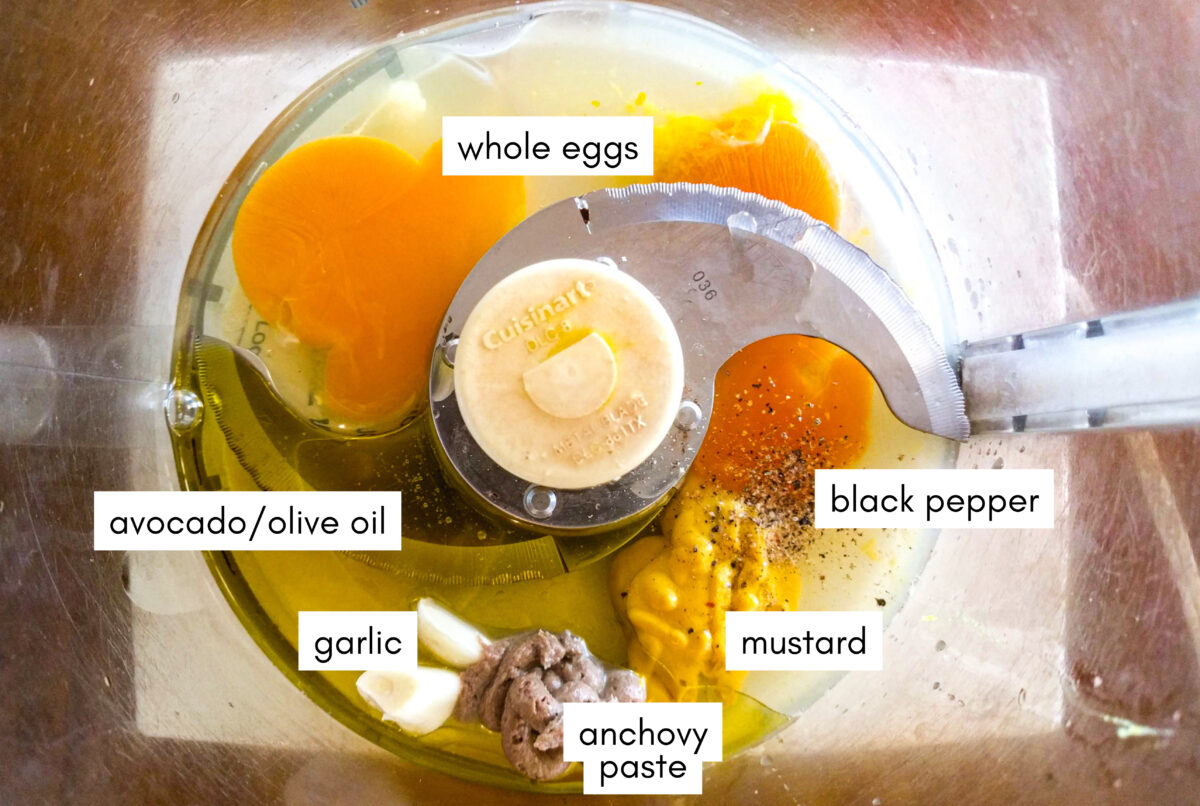
- Eggs – As much as you can, try to find the best and freshest eggs you can.
- Lemon juice – Lemon juice adds zest and a little tang to your homemade Caesar dressing salad. Use fresh lemons and squeeze it out, or keep a bottle of this single ingredient lemon juice in your fridge.
- Olive oil / Avocado Oil – I recommend using either extra virgin olive oil or avocado oil in this recipe. The stronger the flavor of the oil that you use, the stronger the flavor o your dressing.
- Anchovy paste – This recipe uses anchovy paste, which adds a ton of umami flavor. Check the ingredients on your anchovy paste to make sure there’s just anchovies, olive oil, and salt. I use this brand.
- Mustard – Use what you like best, and what you have. Yellow mustard or Dijon will work well.
- Garlic cloves – Fresh garlic cloves (zested) adds a nice kick to your Caesar dressing.
- Parmesan cheese – To add that delicious cheesy flavor (optional). Omit for a dairy-free Caesar dressing.
- Black pepper – Add as much as you’d like.
How to Make Your Homemade Caesar Salad Dressing Without Mayo
I’ll show you how to make Caesar dressing using a food processor. If you don’t already have a food processor, I highly recommend this one!
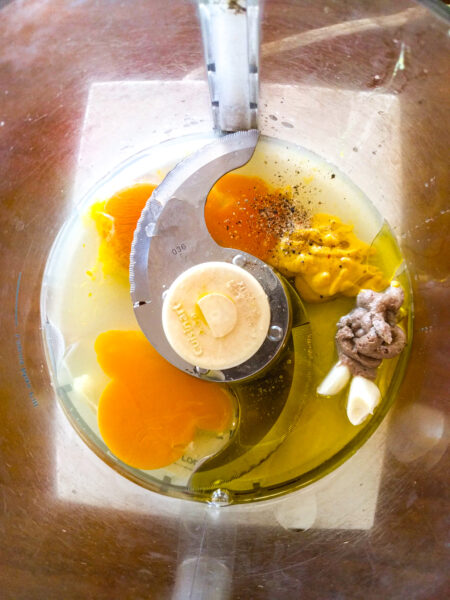

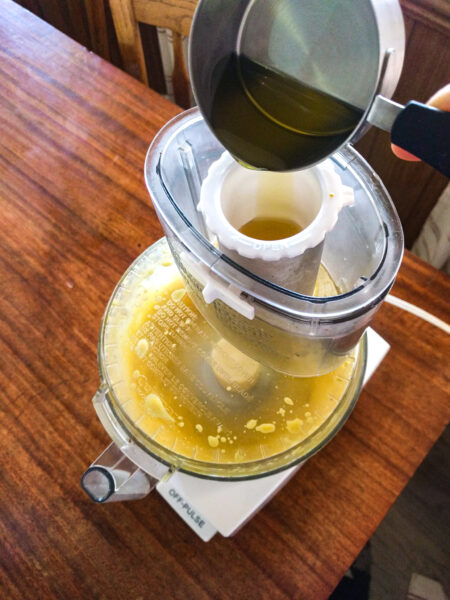
Step 1: Put all the ingredients (except one cup of the avocado oil and parmesan) in the bowl of your food processor. Turn it on for 30 seconds to blend everything together.
Step 2: With the food processor on, pour the last cup of the avocado oil into the “pusher”. This is the part of the food processor that fits in the lid and has a tiny hole at the bottom. The hole in the bottom lets the oil drip in so you don’t have to stand there and pour slowly.
Note: If you don’t have a “pusher” with a hole in it, just drizzle the oil in slowly with the food processor on. I aim for a thin stream (somewhere between dripping it in and dumping). Drizzling the oil should take a minute or two, not thirty.
Your dressing should be perfectly thick now. If you want to add Parmesan, now would be the time to do that.


Caesar Salad Recipe
Once you’ve made the dressing, it’s time to put your Caesar salad together. Put these items in a bowl for the perfect Caesar salad:
- Romaine lettuce – Washed, dried, and chopped.
- Croutons – You can make your own or use a gluten-free and keto-friendly option if needed.
- Parmesan – Omit for a dairy-free Caesar salad.
- Salad dressing – I (obviously) recommend this recipe (find the full recipe below).
- Extra black pepper – If you’re a pepper lover.
FAQ & Recipe Tips
Worcestershire sauce, capers, or kalamata olives are options for a substitute for anchovy paste (although I haven’t tested these personally).
This recipe is gluten-free, dairy-free (just leave out the parmesan), and Paleo-friendly all in one. In this recipe, avocado oil (or olive oil) is used, which is good for your health as well as your taste buds.
Traditional Caesar salads contain croutons, which are usually not keto-friendly. Most Caesar salad dressings will be keto-friendly because of their high-fat content and low-carbs.
Yes! This homemade Caesar dressing may be stored in the refrigerator for up to a week. I don’t recommend dressing the salad until you’re ready to eat it though (as the lettuce will get mushy).

Related Recipes
Looking for more delicious homemade salad dressings? Here are a few more on the blog:
- Creamy Avocado Lime Salad Dressing
- 4 Ingredient Honey Mustard Salad Dressing
- Sesame Ginger Salad Dressing
- 5 Minute Caesar Dressing From Mayo

Homemade Caesar Dressing
Make this homemade Caesar dressing easily with your food processor. Made with simple ingredients, your favorite salad just got better.
Ingredients
- 2 whole eggs
- 2 Tbsp lemon juice
- 2 tsp anchovy paste
- 2 tsp mustard
- 2 cloves garlic
- 1 cup + 2 Tbsp avocado oil (or olive oil)
- 2 Tbs parmesan cheese (optional)
- black pepper, to taste
Instructions
- Put the eggs, lemon juice, 2 Tbs of olive oil, anchovy paste, mustard, and garlic in the bowl of your food processor.
- Turn your food processor on for 30 seconds, until everything is blended
- With the food processor running, either use the "pusher" in your food processor to drip the oil in, or just slowly pour the avocado oil into the bowl while the food processor is running.
- Let it mix for 2-3 minutes, until it's thickened a bit and all the oil has been incorporated.
- Add black pepper to taste
- If you want parmesan cheese in your dressing, stir it in now.
- Enjoy!
Notes
- Get the freshest eggs you can find, since this recipe uses raw eggs.
- You can store this dressing in the fridge for 5-7 days.
- For a dairy free option, just omit the Parmesan.
Nutrition Information:
Yield: 16 Serving Size: 1Amount Per Serving: Calories: 90Total Fat: 9gSaturated Fat: 1gTrans Fat: 0gUnsaturated Fat: 8gCholesterol: 24mgSodium: 67mgCarbohydrates: 1gFiber: 0gSugar: 0gProtein: 1g
Don’t forget to save for later on Pinterest!
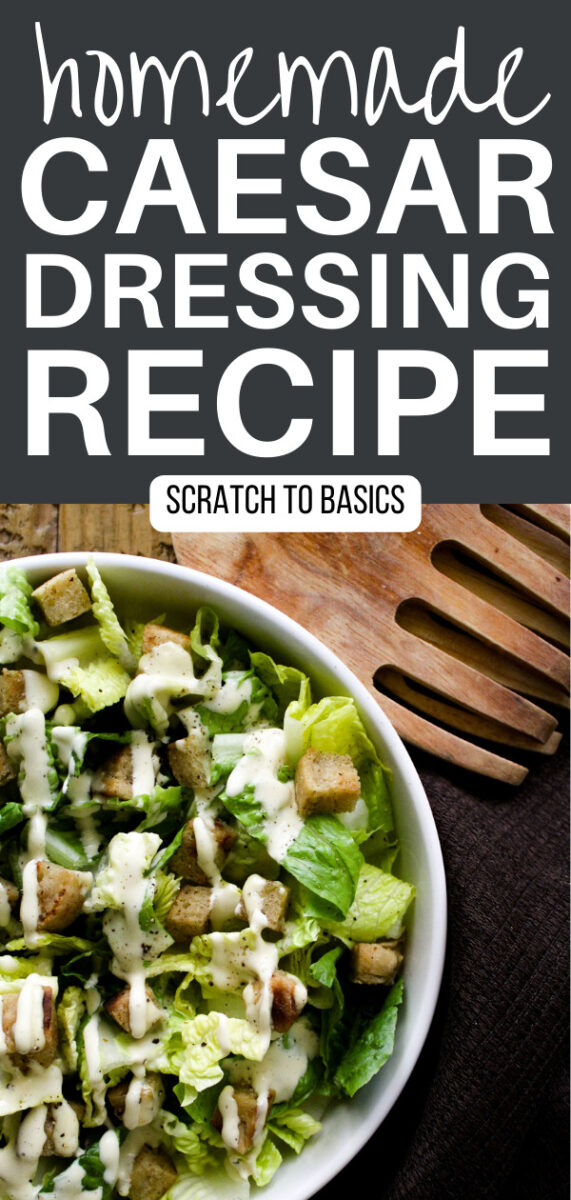
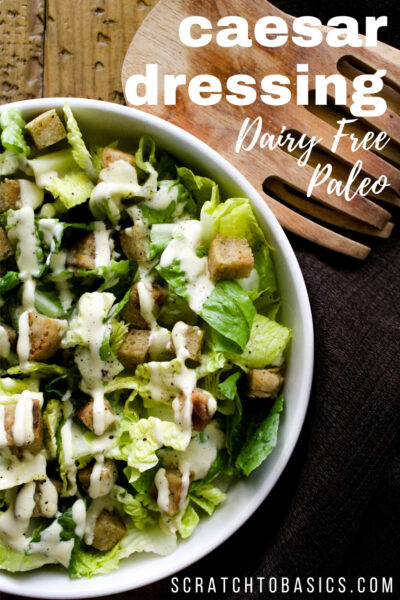


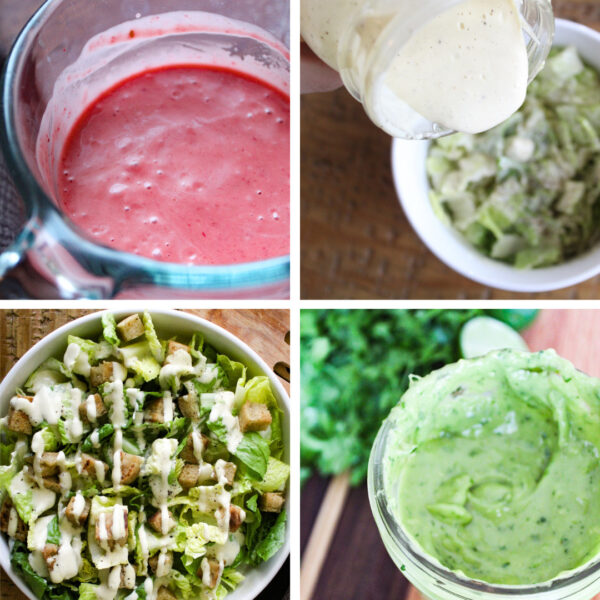
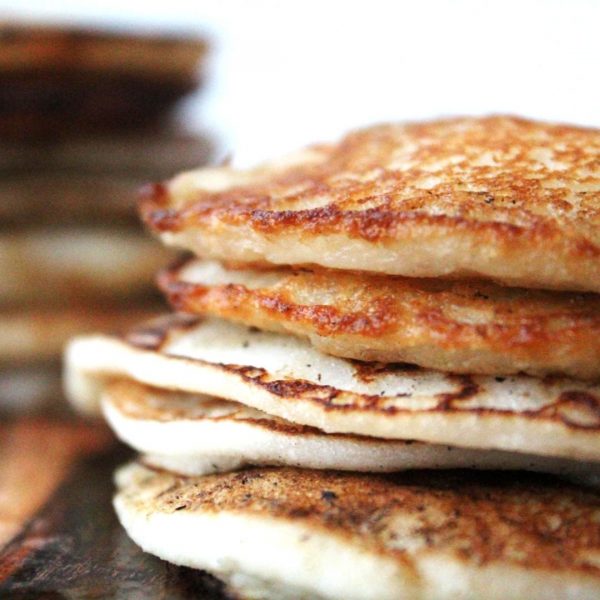
![5 Minute Healthy Peanut Sauce [Gluten Free]](https://www.scratchtobasics.com/wp-content/uploads/peanut-sauce-on-spoon.jpg)



I know this is a old post, but I have been searching and searching for help as to why when I make homemade dressing with an egg yolk, after being in the fridge the egg coagulates in the jar and no amount of re-mixes breaks it up, it almost like it becomes a blob of cooked egg. Why is this happening and what can I do to prevent. I use vinegar, oil, egg yolk and spices.
Hi Brenda, What kind of oil are you using when this happens?
Hello,
I use olive oil. Red wine vinegar and spices. Thank you for the reply.
Brenda, I’ve had that happen before, too when using olive oil. If you put the oil in the fridge by itself and it hardens, it’s going to do the same thing when it’s mixed together with oil. I’m guessing this is what’s happening. So you’re seeing hardened oil blobs mixed with the liquid
egg. I would recommend trying a different oil to see if that changes anything. I just did a quick google search and a lot of different factors go into whether an oil will harden in the fridge or not. So it might take a couple tries to find one that works for you. I’m using avocado oil and so far I haven’t had this happen. You could try a refined olive oil to see if that helps it stay together. I’m curious to hear how it goes!
The oil is not what is hardening, it is the egg that is coagulating. I did more research and it seems that vinegar will turn egg into a rubber blob.
https://www.scienceprojectideas.org/egg-in-vinegar-experiment.htm
I use lots of vinegar because I like it really tart. So I think it is the fact that I am using so much vinegar and it is affecting the egg. I will keep experimenting. Thanks for the replies. I appreciate it.